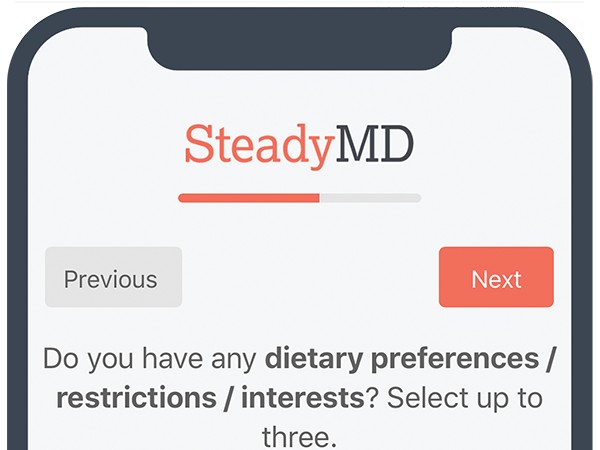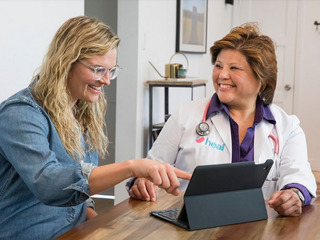

There are no shortage of telehealth and telemedicine companies out there right now that people can use to access a doctor (you can probably think of three or four right off the top of your head). The most typical use case for many of those services, though, is urgent care; if you have a pressing need or an emergency, you can get access to a doctor whenever you need one.
What those services typically don’t offer is an ongoing relationship with a primary care doctor, and a platform where you can access the same doctor over a long period of time. That’s the idea behind SteadyMD: the company uses data to pair the right patient to the right doctor, and then allows the patient to contact that doctor whenever they have a problem.
“I would describe the value proposition of the typical telemedicine company as: you can press a button and a random doctor will talk to you for an urgent care visit. They execute on that very well. What we’re offering is a long-term, dedicated relationship with a physician who’s aligned with your life, that knows you,” Guy Friedman, CEO and co-founder of SteadyMD, told me in an interview.
“If you want to find a random doctor to treat you for an urgent care issue, that problem has basically been hammered on and solved. If you want a doctor that knows who you and you have a relationship with, that’s pretty hard to come by and that’s the problem we solve.”
On Thursday, the company announced a $6 million Series A financing led by Pelion Venture Partners and Next Ventures, with participation from First Trust Capital Partners, The Daube Family office, Crosscut Ventures, M25 Group, Wild Ventures, and Hyde Park Venture Partners. This brings the company’s total raised to $10.5 million.
In addition to the funding, it was also revealed that Darren Phelan, M.D. of Next Ventures is joining the Board of Directors at SteadyMD.
“Darren couldn’t be more perfect of a fit. He has run his own concierge clinic so he knows the operational stuff really well, and he has a deep resume of corporate experience, as well as having served technology companies as an on-premise doctor. So, operationally, he brings a ton to the table. I’m not sure there’s another doctor in America that would have been a better fit for our operations, because not many doctors have run concierge clinics and are also really business savvy and know the corporate world as well,” said Friedman.
“Also, he’s just philosophically aligned with us in terms of personality and culture, so we’re really excited to have him.”
A deeper relationship
Founded in 2016, SteadyMD provides a matching engine that evaluates hundreds of criteria from its patients around things like fitness, exercise, diet and medical condition. Those data points are then matched to a doctor’s lifestyle or expertise. Once a doctor and patient are matched, the doctors on SteadyMD spend an hour onboarding each patient.
“They get a full hour with the doctor to go over your medical history, family history, your care plan, what you want to work on and get to know the doctor and establish rapport and friendship as well,” said Friedman.
After that, the patient is able to connect with the doctor via phone or video, but will typically engage through its chat app, which offers asynchronous communication, meaning the conversation has no set end date; it can last 10 minutes or 10 weeks, depending on what’s necessary.
“Because the platform is designed around this idea of familiarity and a relationship, there’s a lot more touch points in between the patient and a doctor, as compared to a typical primary care operation which you’d have to book a 15 minute appointment, and there’s an average of a two week wait to see a primary care.”
SteadyMD is a subscription service, and its offer four services, including it’s core primary care service, with costs $99 a month, as well as pediatric care, which is cheaper. The company also offers a functional medicine service for $199 a month, which Friedman describes as “kind of an enhanced version of primary care.”
“It’s a very deep dive into the root cause of your health. It’s a much longer intake process, much longer onboarding and more extensive testing,” he explained. “It’s pretty popular with folks who want to get to the root cause of issues, and do deeper dive.”
Finally, SteadyMD has an enterprise-focused product that it released in the last year or two.
“The employer model is the same value proposition: it’s employers that want their employees to have a doctor that knows who they are and takes care of them in the long-term, on a really robust application and platform,” said Friedman.
“A lot of employers are coming to us and they know a more engaged employee that participates in their healthcare is going to save them money in the long run.”
The major difference between what SteadyMD offers and the experience a patient gets from a typical primary care relationship comes down to the number of patients a doctor sees: on SteadyMD it’s 500 to 600 patients, compared to 2,500 to 3,000 patients for a primary care doctor who is billing insurance. So, instead of seeing each patient for just 10 minutes and spending half of their time coding and billing insurance; that’s why the doctors on SteadyMD are able to spend one hour with each patient when they first come on board.
“It’s a very different type of relationship. If you think about just the raw number, not billing insurance saves you half the time, then we cap the patient panel at one fifth or one sixth of a typical primary care doctor, so that’s how much extra time they have,” said Friedman.
That ongoing relationship also leads to a higher engagement rate among patients, where 70 percent of them message SteadyMD at least once every three months, and 40 to 50 percent message at least once a month. That includes both patients reaching out to doctors when they’re sick, as well as them responding to SteadyMD, which makes sure to check in on patients at least once a month.
Creating a new category of healthcare
The company is going to use the new funding to enhance its existing product, including its onboarding, patient matching and communication platform.
“We’re going to keep doing what we’re doing, which is executing really well on this vision of the long-term from a doctor who knows who you are and who you have a relationship with. We’re going to continue with that vision. We fundamentally believe that that’s a better care model than seeing a random doctor every time,” Friedman said.
“We can do almost everything we want to do right now. It’s you can always make enhancements around stability and automation and just a better experience. That’s like swimming in the ocean: you never stop, you can swim forever.”
Ultimately, the company’s belief is that is model of providing ongoing virtual care is what is best for patients in the long run, as well as being the better business model.
“If someone signs up, we think and believe and I almost know that we’re taking care of them in a better way than they would have experienced otherwise. That’s what drives us. I’d love for as many people as possible to be on the platform, getting care from doctors that are aligned with their life. It’s really maximizing that and getting that into as many hands of as many people as possible,” Friedman explained.
“In primary care, you have your acute care, where you’re either going to go to a retail operator or an urgent care, a primary care office, to get your throat swabbed for strep or a bandage up for a cut. But your long-term relationship with your primary care doctor is going to be on SteadyMD. We’re creating a new category that’s dedicated primary care doctors completely online. That hasn’t really been tried before at scale. I’m really proud of what the team has accomplished so far and I can’t wait to keep growing this thing.”
(Image source: steadymd.com)



















